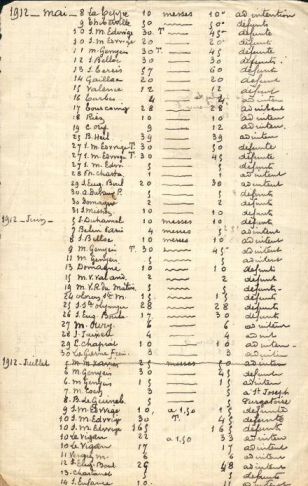The Sale of Masses (1892)
19.03.2024
From the website of Mariano Tomatis.
The material is distributed under a Creative Commons BY-NC-SA 4.0 license.
In addition to the salary dispensed by the French state, priests had two other sources of income: the request for gifts from the faithful and the sale of suffrage masses. The latter could not be offered directly to the parishioners, but had to be solicited by the bishop's secretariat, who divided them fairly. As the instructions given to the priests by Bishop Billard in 1886 were read:
“ON THE HONORARIES OF THE MASSES – The lords priests, those who request offerings and the other priests of the diocese who fail to celebrate, in the prescribed time, all the masses requested of them, are invited to deposit these intentions, together with their honoraries, to the Secretariat of the Bishop, who will have the task of distributing them to the priests of the diocese who do not have any”(1).
However, Saunière should not like the criteria followed by the secretariat for distributing requests too much; believing that this body favoured certain priests to the detriment of others, he decides to organise it himself. In a questionnaire that he will send to his lawyer in 1910, the parish priest will tell that on his arrival in Rennes there was a great shortage of requests, for which he had addressed, together with other parish priests in the area, to the episcopal secretariat:
“These gentlemen, after having satisfied our requests two or three times, began to kindly say goodbye to us, telling us that they had no more. Even after a few subsequent requests we didn't get anything. The secretariat had no more masses for us. In reality he had some, we knew it and we had proof of it; but the fees of those masses were not intended for us, poor country curates. Tired of insisting, we began to turn to some religious community of which some more charitable priest had given us the address and, in fact, the fees of the masses did not take long to arrive, and came in large numbers” (2).
During 1892, the gain from sales amounted to 955 francs, compared to 747 masses, from which an average tariff of 1.2 francs can be calculated (3). The number of celebrations, although not excessive, is higher than that allowed by the code of canon law, which provides for a maximum of one mass per day on weekdays and three on public holidays, for a total of about 450 masses per year (4). In his notebooks, Saunière carefully notes the date of receipt of the money, the name of the applicant and the date on which he celebrates each mass.
1) Cit. in Jacques Rivière, Le fabuleux trésor de Rennes-le-Château, Bélisane, 1983, p. 127.
2) Claire Corbu, Antoine Captier, L'héritage de l'Abbé Saunière, Bélisane, 1995, p. 181.
3) Jean-Jacques Bedu, Rennes-le-Château, autopsie d'un mythe, Loubatières, Portet-sur-Garonne 2002, p. 126.
4) Code of Canon Law, c.905 §1-2.

|

